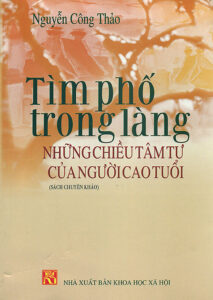
Nguyen Công Thảo
Vietnam Social Science Publishing House, Hanoi, Vietnam, 2020
Reviewed by Thanh Bui Viet (PhD candidate, Vietnam National University Ho Chi Minh City, University of Social Sciences and Humanities & HYI Visiting Fellow)
Seen from the diverse aspects of history, economy and socio-culture, the Vietnamese village has become a popular subject of research. “In Search of the City: State of Mind of the Elderly in the Village” – a research work by Nguyen Cong Thao – also takes “Vietnamese villages” as its specific subject. The author has published other articles in journals of Anthropology and Ethnography, such as: Vanishing Ghosts and the Restoration of Sacred Places in a Vietnamese Village (2012), Village Landscape Transformation: The Elderly and their Loneliness (2017), which gave readers a new perspective from previous and more traditional research. The book is divided into five chapters as follows: Chapter 1 – Vietnamese villages: A world or a perspective; Chapter 2 – Duc Noi Village; Chapter 3 – The landscape of Doc Village since the Renovation; Chapter 4 – The new landscape and the Elderly; Chapter 5 – Modernization: Stairways or Paths. In particular, rather than studying Vietnamese villages as a whole or focusing on villages in a specific region, the author chose the village where he was born as the subject of his research. The book looks further into the ecological transformation of Duc Noi, a village on the outskirts of Hanoi, in the whirlwind of urbanization from the perspectives of both the people living inside and outside the village, as well as from the author himself. From these points of view, the author makes good use of both American Anthropology and French Ethnography to produce research with scientific values.
The strength of the author is that he focuses on exploring the social space of a particular village – where he was born and raised – with three main manifestations: (1) physical structure of the village (architecture of public spaces, houses and home gardens); (2) production space and community space (hamlets, marketplaces, ponds and wells); and (3) sacred spaces (communal house, pagoda, shrine and other holy places). The farmers’ living space is seen as a system connected to those three elements. If one of them disappears, it will hurt people of the village, especially the elderly, who often live with nostalgia. The study also points out that the traditional village cultural space is in line with the lifestyle of rice farmers in the Red River Delta since it satisfies the needs of daily life and of the concept of feng shui and spirituality, and that it is necessary to restore cultural resources to ensure the sustainability of the village. The elderly are a focus of the author’s research because they are vulnerable both physically and mentally as the rural village is transforming into an urban area. With an ecological and anthropological approach, the author explains and discusses the cultural aspect of modernity from many perspectives, bringing new discoveries and contributions to the study of Vietnamese villages in the Red River Delta. Nguyen Cong Thao also raises awareness of the undeniable importance and value of indigenous culture in creating a living space for farmers in the Red River Delta, and that the planning, construction and development of rural areas today need to learn from and inherit the values that have been accumulated from thousands of previous generations. The author also proves that modernity is not rigid, but rather it is evolutionary and also related to traditions and, in quite many cases, it inherits from traditions instead of going against or eliminating them.
This book is of great significance in the fields of cultural anthropology and rural anthropology, as well as for the study of agricultural and rural culture of Vietnamese people in the Northern region in the new context.
